The Portrait in Erfurt Alleged to Depict Bach, the Weimar Concertmeister - Is this young man really Johann Sebastian Bach? Pages
at The Face Of Bach
Page 1
The Face Of Bach
This remarkable photograph is not a computer generated composite; the original of the Weydenhammer Portrait Fragment, all that
remains of the portrait of Johann Sebastian Bach that belonged to his pupil Johann Christian Kittel, is resting gently on the surface
of the original of the 1748 Elias Gottlob Haussmann Portrait of Johann Sebastian Bach.
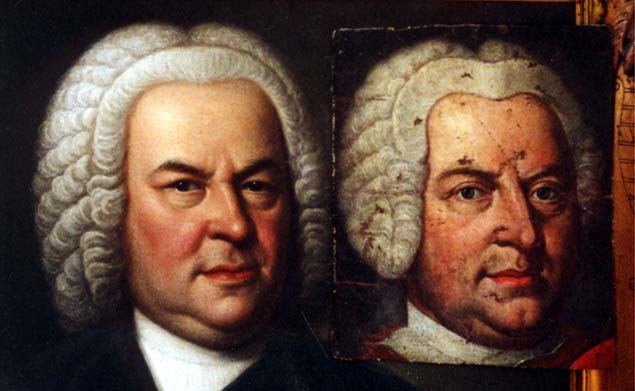
1748 Elias Gottlob Haussmann Portrait, Courtesy of William H. Scheide, Princeton, New Jersey
Weydenhammer Portrait Fragment, ca. 1733, Artist Unknown, Courtesy of the Weydenhammer Descendants
Photograph by Teri Noel Towe
©Teri Noel Towe, 2001, All Rights Reserved
The Portrait in Erfurt Alleged to Depict Bach, the Weimar Concertmeister
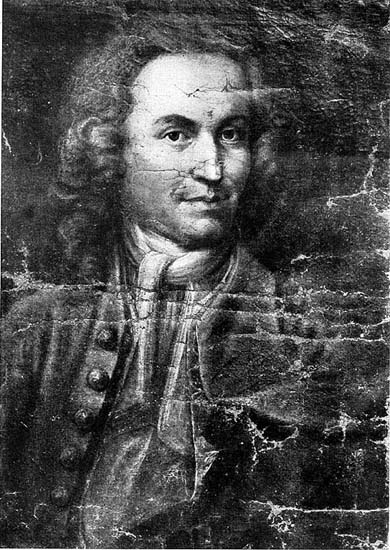
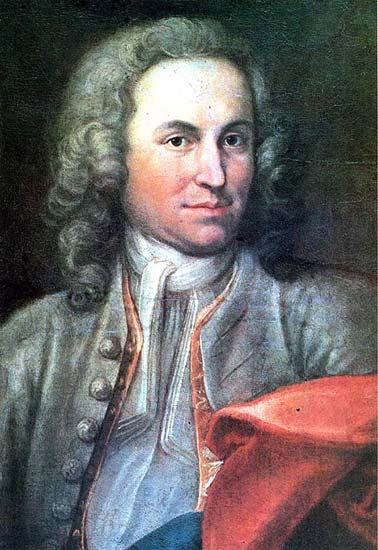
Before the 1907 Restoration and As It Looked in 1985
Is this young man really Johann Sebastian Bach?
Page 1
Some Preliminary, But Nonetheless Confident, Conclusions About the Authenticity of
The Portrait in Erfurt That is Attributed to J. E. Rentsch, the Elder, and
That Is Alleged To Depict Johann Sebastian Bach While at Weimar
During the hectic weeks in August of 2000, during which I constructed the initial portions of The Face Of Bach, which were then
focused exclusively on the process of demonstrating that the Weydenhammer Portrait Fragment is, in fact, not only an accurate and
authentic depiction of the face of Johann Sebastian Bach and a portrait from life but also what remains of the long lost portrait of
Johann Sebastian Bach that belonged to Johann Christian Kittel, I sat down to talk about the Bach portraits with an old and
treasured friend and colleague who is universally regarded as one of the foremost writers on classical music in the word today. At
one point in our conversation, during which I showed him my reasons for believing the Weydenhammer Portrait Fragment to be
authentic, he remarked that it was something of an irony that two of the most widely reproduced portraits were widely regarded with
suspicion, and that it was by no means definite that they did, in fact, depict Johann Sebastian Bach.
Those two portraits are, first, the painting now in the Bach Museum in Eisenach, that is attributed to J. J. Ihle and is alleged to
depict Johann Sebastian Bach during his tenure as Capellmeister to Prince Leopold von Anhalt-Cöthen, between 1717 and 1723
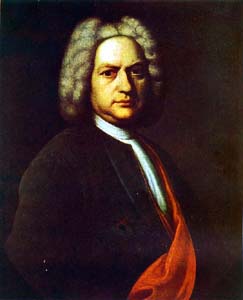 , and, second, the portrait attributed to the Weimar Court Painter, J. E. Rentsch, the Elder (d.
1723), now in the Angermuseum in Erfurt, that is alleged to depict Johann Sebastian Bach during the years that he spent in Weimar,
as Court Organist and Concertmeister, between 1708 and 1717
, and, second, the portrait attributed to the Weimar Court Painter, J. E. Rentsch, the Elder (d.
1723), now in the Angermuseum in Erfurt, that is alleged to depict Johann Sebastian Bach during the years that he spent in Weimar,
as Court Organist and Concertmeister, between 1708 and 1717 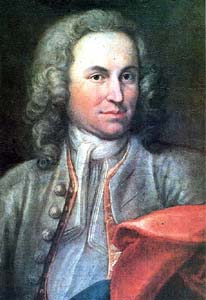 .
.
I told this friend and colleague that I harbored strong doubts about the authenticity of both of these images, but that, while,
eventually, I would put both portraits through the same rigorous comparisions to which I have so far subjected the Weydenhammer
Portrait Fragment, the Volbach Portrait, and the Group Portrait Attributed to Denner, I would not deal with the picture in Erfurt until
I had been able to find a photograph that I knew I had seen, a photograph that showed the painting, which was in very poor
condition when it was found and identified, before it was restored, because it was an essential and indispensable component of the
authentication process.
The Erfurt Portrait is yet another Bach portrait that I have known since my childhood. It was one of the first "alternate" portraits
that I saw. I encountered it for the first time when I was about 12. Esther Duffy, the then Performing Arts Librarian at the Greenwich
Public Library, bent the rules and allowed me to borrow records, even though I was nowhere near the minimum age of 16. It is a
kindness for which I shall always be grateful. I recall that one of the first recordings I borrowed was Agi Jambor's two record set of
the Seven Toccatas and Four Fantasias (Capitol SBR-8354), for over a decade the first and only recording of all of the Toccatas.
The liner notes contained this image; it was my first encounter with what is often the first image that pops into peoples' minds when
you speak the words, "Bach portrait":
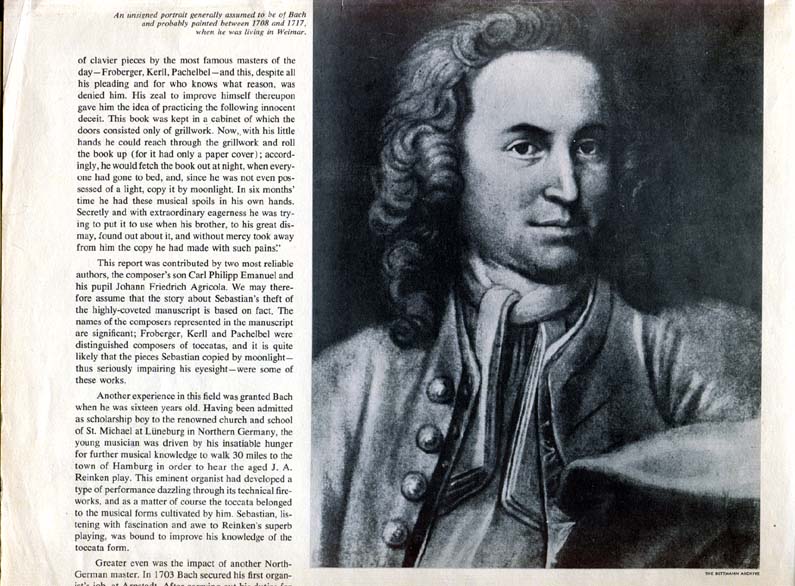
Even as an admittedly obnoxious "precocious brat" of a 7th grader, I took notice of the guarded and carefully worded caption: "An
unsigned portrait generally assumed to be of Bach and probably painted between 1708 and 1717, when he was living in Weimar."
(Incidentally, those who have read the other pages here at The Face Of Bach are well aware that I am both a sentimental cuss and a
packrat, and it will come as no surprise to them to learn that, when I serendipitously and fortuitously came across that very two disc
set at a Greenwich Public Library de-accessioning sale many years later, I bought it. Not only is that one reason why I am able to
quote that caption accurately, but also the scan was made from that very copy!)
Questions of authenticity are not conundrums that children customarily think about, but I remember that even then I was puzzled by
the cautious caption: "An unsigned portrait generally assumed to be of Bach and probably painted between 1708 and 1717, when he
was living in Weimar." The portrait puzzled me for other reasons, too. It was the first image of Bach that I saw that did not fit the
"white wigged" image of the 1746 and the 1748 Haussmann Portraits, the Volbach Portrait, and all of the images derived from them.
It was also the first time that it occurred to me that not all of the images that I had seen that purported to show the face of Johann
Sebastian Bach were actually or necessarily "as billed".
In the 40 years since I first saw that reproduction of the Erfurt Portrait, this image of Bach has become particularly well known to
the world at large. It is the portrait almost invariably selected when a portrait of the composer is needed for the booklet that
accompanies a recording of "early" works by Johann Sebastian Bach.
But is the man in the Erfurt Portrait actually Johann Sebastian Bach?
Once I began work on The Face Of Bach, this question became one that, ultimately, I knew that I would have to try to answer, and
I soon discovered that I would have to answer it sooner rather than later, whether I liked it or not.
Please click on  to go on to Page 2.
to go on to Page 2.
Please click on 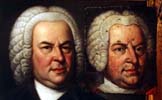 to return to the Index Page at The Face Of Bach.
to return to the Index Page at The Face Of Bach.
Please click on  to visit the Johann Sebastian Bach Index Page at Teri Noel Towe's Homepages.
to visit the Johann Sebastian Bach Index Page at Teri Noel Towe's Homepages.
Please click on the 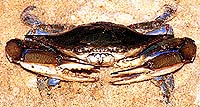 to visit the Teri Noel Towe Welcome Page.
to visit the Teri Noel Towe Welcome Page.
TheFaceOfBach@aol.com
Copyright, Teri Noel Towe, 2000 , 2002
Unless otherwise credited, all images of the Weydenhammer Portrait: Copyright, The Weydenhammer Descendants, 2000
All Rights Reserved
The Face Of Bach is a PPP Free Early Music website.

The Face Of Bach has received the HIP Woolly Mammoth Stamp of Approval from The HIP-ocrisy Home Page.